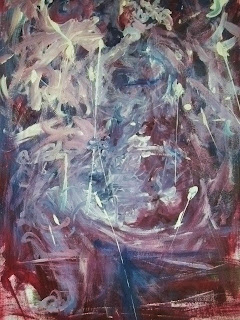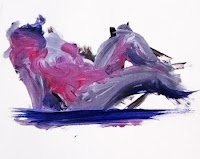 |
| One of my preparatory portraits for Salome |
Salome was the niece and stepdaughter of Herod Antipas, depicted as an old letch in the Bible, and by Josephus, the 1st century Jewish/Roman historian.
Herod (one of a gaggle of Herods at this time, all related to one another and all fairly disgusting) had divorced his first wife and married his brother’s wife, who was also their half-niece (hope you are following this - they were a kinky lot). He was a client King of the Romans, a Tetrarch - i.e. one of four such Kings, who spent his reign in a series of manoeuvrings and power games to keep himself on the throne… until he finally failed, was deposed by his first wife’s brother and exiled.
‘How different from the home life of our own dear Queen.’
So the court of Herod was a place of conspiracies, of whispering behind closed doors, of uncertainty, of machinations, of currying favour, of fear of the assassin’s knife, or the mob beyond the gates, or the invading army. There are definitely analogies with Hamlet and Elsinore.
The story is that John the Baptist was banged up in Herod’s dungeon for preaching and fulminating against his marriage and second wife, Herodias. Herod’s niece/wife persuades her dozy daughter, Salome, Herod’s niece/stepdaughter (do keep up, it’s really just like The Archers), to dance for him and instructs her to ask for the head of John the Baptist in payment.
Salome duly does this, whips off the seven veils, reveals all her naughty bits to Herod, and John loses his head in the crisis.
 |
| Titian |
Until the late 19th Century, Salome seems to have been regarded as the Ultimate Blonde, a dippy girl who does not know what she is getting herself into; a sort of sexy Ophelia figure caught up in the power play and machinations of Herod’s court.
 |
| Carravaggio |
Depictions of her either show her as pretty much oblivious to what is going on around her, as in the painting by Titian or disgusted by what she has done as in Caravaggio's interpretation.
 |
| Moreau - early Salome painting |
Late in the nineteenth century, something seems to have happened in how Salome was viewed. Perhaps as a result of the sexual repression of the age or because of a growing male fear of female power, she starts to be seen as an embodiment of female sexual manipulative power, the archetype of the femme fatale.
 |
| Moreau - Salome |
This seems to have started with Gustav Moreau around the 1860s, who had a bit of an obsession with Salome, creating numbers of very different images of her. His paintings initially showed her much as the innocent pawn, unaware of her own sexuality, but the later works imbue her with a potency of her own, rather than derived from her mother or Herod.
I love the Moreau paintings for their richness, dark mood and subdued yet luxuriant colour.
 |
| Moreau - later Salome painting |
 |
| Franz Von Stuck |
The Moreau paintings set off a whole Salome industry. She was an ideal subject for the Decadent and Aesthetic movements of the fin de siecle, embodying much of their delight in what they saw as the corruption and decay of civilisation. Many rather second rate paintings around this time depict her dangerous sexuality, but lacking the subtlety of Moreau, their over the top depiction of her as a femme fatale make them a bit of a joke to today’s more cynical eye.
 |
| Beardsley |
Salome was eventually taken up as the subject of a play by the arch-Decadent, Oscar Wilde, illustrated by the seriously sexually repressed Aubrey Beardsley. There is lust, blood, death, suggestions of paedophilia and heads on dinner plates all over the place and Salome at the end gets squished to death by the shields of the royal guard, destroyed by Herods disgust at his powerlessness in the face of her dangerous female sexuality. All a bit too much, I feel.
However, eventually we come to good old Picasso in the early 20th century. He is such a fraud, and often you look at his work and think ‘you can’t be serious’. And then he produces something so acute and incisive that you realise he wasn’t serious, he was taking the piss all along and the joke is on you.
 |
| Picasso: Salome dancing |
His Salome is a bit like this. At first it looks half finished or knocked off in an idle moment. And possibly it was. But once you know the Salome story and the characters involved you see how clever he is. In his youth, Picasso was part of the Modernista movement in Barcelona - the Spanish version of Art Nouveau - all part of the fin de siecle world of the Decadents - so he would have been very familiar with previous interpretations of the Salome story.
There is Herod, a paedophilic old soak, drunk with power that he can’t handle, Herodias, a menopausal manipulator, jealous of her own daughter’s youth and beauty, unable to resist using her to play power games and of course poor old John, out of it already in the arms of an old servant.
Now look at Salome. She is adolescent, apparently far from innocent and blatantly displaying herself. However, her coquettishness is that of the pubescent girl, as yet unaware of the effect she has on men. Picasso manages to make her the femme fatale and Ophelian innocent at one and the same time.
 |
| One of my preparatory sketches for Salome |
I am never going to achieve that level of subtlety. I have been working on figures and portraits to improve my technique and to help me think about how I might portray Salome – all the time I am going to try to create an atmosphere of ambiguity, in depiction and in the theme. Leaving more unsaid.



































